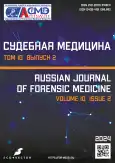Comparative anatomical characteristics of the distal parts of bear and human limbs
- Authors: Iudina A.M.1, Veselkova D.V.1
-
Affiliations:
- Institute of Archaeology Russian Academy of Sciences
- Issue: Vol 10, No 2 (2024)
- Pages: 181-200
- Section: Original study articles
- URL: https://journal-vniispk.ru/2411-8729/article/view/262743
- DOI: https://doi.org/10.17816/fm16106
- ID: 262743
Cite item
Abstract
BACKGROUND: The comparative morphology of the human and animal skeletons has been incompletely described in the forensic medical and anthropological literature. Moreover, bones of the distal parts of bear limbs are anatomically similar to those of humans. Together with some features of the bear’s skeleton, poor preservation, absence of claws, and incomplete remains, difficulties and errors may occur during identification.
AIM: To create an illustrative material describing morphological features important for the identification of each element of the distal parts of bear limbs in comparison with humans.
MATERIALS AND METHODS: Preparations of the distal parts of the right thoracic and right pelvic extremities of the bear were made using osteological materials. The missing talon phalanges of a bear and bones of a human hand and foot were taken from the institute collections. The International Veterinary Anatomical Nomenclature was used to describe the anatomical features of bear bones, and the latest recommendations of International Anatomical Terminology were considered for human bones.
RESULTS: Each bone of the bear’s hand and foot was described in comparison with a similar human bone. For greater versatility, descriptions were made in terms of the international zoological nomenclature. For all bones, except for distal sesamoid bones, high-quality photos are provided for aspects that are important for identification. Comparative anatomical analysis showed that the bones of the wrist differ to a greater extent, whereas all tarsal bones, which are part of the human foot, had analogs in the bear foot and had closer measurements. The articular surfaces of the heads of the metacarpals and metatarsals showed specific ridges articulating with the cutouts at the bases of the proximal phalanges of the fingers. In addition, the bear’s hand and foot contained numerous inset sesamoid bones and claw-like processes on the distal phalanges of the fingers.
CONCLUSION: Comparative anatomical analysis showed similarities in the structures of the bones of the hand and foot of a brown bear and a human caused by foot walking. Owing to the morphological similarity, bone identification can be difficult. The set of features described in the article, which are specific to bear bones, in combination with illustrative material will help in identifying bones more accurately, even for individual bones.
Keywords
Full Text
##article.viewOnOriginalSite##About the authors
Anastasiia M. Iudina
Institute of Archaeology Russian Academy of Sciences
Author for correspondence.
Email: iudinaanmi@gmail.com
ORCID iD: 0000-0002-2456-0948
SPIN-code: 4604-6844
Russian Federation, Moscow
Daria V. Veselkova
Institute of Archaeology Russian Academy of Sciences
Email: daria.veselkova@yandex.ru
ORCID iD: 0009-0000-5311-6582
SPIN-code: 1635-2548
Russian Federation, Moscow
References
- Avdeev AI, Potereykin KS. Differential diagnostics of species affiliation of distal parts of the lower (hind) limb of man and bear. In: Selected issues of forensic expertise: materials of scientific research of forensic physicians of the Far East. Issue 9. Habarovsk, 2008. Р. 114–116. (In Russ). EDN: USXCZY
- Dogăroiu C, Dermengiu D, Viore V. Forensic comparison between bear hind paw and human feet. Case report and illustrated anatomical and radiological guide. Rom J Legal Med. 2012;20(2):131–134. doi: 10.4323/rjlm.2012.131
- Pashkova VI, Reznikov BD. Forensic medical identification of personality on bone remains. Saratov: Izdatel'stvo Saratovskogo universiteta; 1978. 320 p (In Russ).
- Zvyagin VN, Anushkina ES. Establishing the species affiliation of bone remains. Politseiskaya i sledstvennaya deyatel'nost'. 2014;(1):178–193. (In Russ). doi: 10.7256/2306-4218.2014.1.9949
- Puchkovsky SV. Brown bear in Russia: Population management. Izhevs: Izdatel'stvo Udmurtskogo universiteta; 2021. 320 p. (In Russ).
- France DL. Human and nonhuman bone identification. A concise field guide. London, New York: CRC Press; 2011. 268 p.
- France DL. Human and nonhuman bone identification: A color atlas. London, New York: CRC Press; 2009. 734 p.
- Pashkova VI. To the question of comparative-anatomical diagnostics of species affiliation of bones in forensic medicine. Forensic Med Exp (Moscow). 1962;(4):27–30. (In Russ).
- Kulichkova DV. On identification of species affiliation of fragments of skeletonised remains, separated individual bones of distal limbs of man and bear. In: Selected issues of forensic expertise. Issue 15. Habarovsk, 2016. Р. 111–125. EDN: ZKJZNR
- Brothwell DR. Digging up bones: The excavation, treatment, and study of human skeletal remains. 3th ed. Ithaca, New York: Cornell University Press; 1981. 208 p.
- Pickering RB, Bachman D. The use of forensic anthropology. London, New York: CRC Press; 2009. 74 p.
- Sims ME. Comparison of black bear paws to human hands and feet. Identification Guides for Wildlife Law Enforcement. 2007;11:1–5.
- Zelenevsky NV. International veterinary anatomical nomenclature in Latin and Russian. Nomina Anatomica Veterinaria. Saint Petersburg: Lan'; 2013. 400 p. (In Russ).
- Abramov AV. Methodical recommendations on preparation of osteological preparations for educational and scientific collections. In: Functional morphology, ecology and life cycles of animals. Scientific Proceedings of the Department of Zoology. Vol. 7. Saint Petersburg, 2007. Р. 115–123. (In Russ).
- Shevchenko BP. Anatomy of the brown bear. Orenburg: Orenburgskii gosudarstvennyi agrarnyi universitet; 2003. 454 p. (In Russ).
- Gremyatsky MA. Anatomy of man. Moscow: Sovetskaya nauka; 1950. 630 p. (In Russ).
- Kruskop SV. Atlas-detector of mammals. Beasts of the middle strip of Russia. Moscow: Fiton+; 2015. 264 p. (In Russ).
- Oshmarin PG, Pikunov DG. Traces in nature. Moscow: Nauka; 1990. 294 p. (In Russ).
- France DL. Comparative bone identification. Human subadult to nonhuman. London, New York: CRC Press; 2017. 840 p.
- Klepinger LL. Fundamentals of forensic anthropology. New Jersey (USA): Wiley; 2006. 200 p.
Supplementary files



























